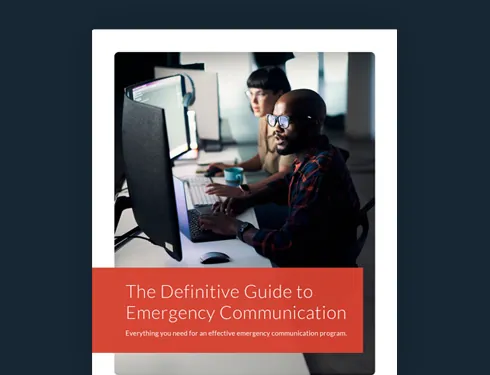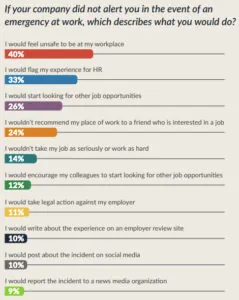
Bridging Communication Gaps in the Workplace for Productivity and Safety
Preventing communication gaps at work isn’t just about filtering your inbox. With these five strategies, learn how to ensure open and relevant communication on your team without mixed messages.

The average worker spends over 30% of their workday on email. Add in Slack, Zoom, and in-person meetings, and it often feels like you barely have time to do your actual job.
Communication is key to nearly every organization’s operations. Yet, employees and bosses alike bemoan the productivity lost to email and meetings, wishing for a more efficient solution. But blaming the tools of communication, like email, Slack, Zoom, and other apps, is often misguided.
Instead, you should be looking at the points where communication goes wrong. Where does top-down messaging fail to hit its intended target? Why are team members failing to share information accurately and effectively? When you identify these areas, you’ll have found the real culprits for lost productivity—communication gaps.
Read on to learn more about what communication gaps are, how they harm your organization’s productivity and safety, and strategies to address them effectively.
The Definitive Guide to Emergency Communication
What Are Communication Gaps in the Workplace?
Communication gaps are failed attempts to convey and/or consume information correctly. The problem can lie with the person providing information, the person receiving it, or a combination of both.
Communication gaps in the workplace can occur in wide-ranging forums:
- One-on-one conversations between coworkers, such as team members working on a task together
- Supervisor and subordinate interactions, like a boss providing instructions to an employee
- Mass emails, posts on an intranet, or other company-wide communications
- Group settings, including face-to-face meetings and conference calls
What causes gaps in communication?
Effective communication is a two-way street, and failures can happen on either side of the equation—or both in some cases. The most common causes of gaps in communication include:
- Physical: Sometimes, physical barriers can hinder communication. These obstacles could be geographic distance, cubicle walls, closed doors, or background noise like exhaust fans or heavy machinery.
- Cultural: In an increasingly globalized world, communication often includes people from a variety of cultures and backgrounds. Communication styles like body language, tone of voice, and word choice can carry different meanings and lead to vastly different understandings of the same information.
- Emotional: Fear, anxiety, and distrust can cause people to provide and consume information incorrectly.
- Interpersonal: While most people strive to be professional in the workplace, humans are still imperfect. At times, personality conflicts can cause communication problems.
- Contextual: Effective communication requires some shared context between speaker and listener. For example, if an accountant and a welder tried to train each other on their respective jobs, they’d probably be lacking the context to share their expertise.
What are the risks of incomplete workplace communication?
In many cases, miscommunication (or lack of communication) results in minor inefficiencies in operations and productivity. Misinterpreted instructions can lead to jobs done incorrectly or wasted time and money. In many cases, this can create more communication gaps—the initial mistake causes frustration, which leads to strained conversations, repeating a cycle of minor problems.
However, communication gaps between employees can also manifest as hazards in safety communication. For example, imagine that a crew at a work site is using a heavy machine that’s not a part of their standard routine. The foreman gives a safety talk in the morning, but he uses overly technical terms, and the workers are too afraid to ask for clarification. The communication gap has created an increased safety risk for the people using the machinery.
Communication gaps can also lead to long-term risks. When employees feel like their employer isn’t being open and honest, it erodes the faith they have in the company. According to the 2023 Employee Safety Report, failing to disclose a workplace emergency would cause a range of negative responses from employees, from feeling unsafe to seeking a new job to contacting the media (see chart on the right).
How do you resolve communication gaps?
The most important step in addressing communication issues is diagnosing the root cause. Imagine you’re the VP of sales for an international company. During a team-wide conference call about training and professional development, you tell your reports that you want them to be talented enough to “sell a ketchup popsicle to someone in white gloves.”
A week later, you discover that the team in your German office has been researching how to make a ketchup popsicle. There’s obviously a communication gap, but there are multiple potential causes:
- You used terminology (in this case an expression) that not everyone had the context to understand
- Cultural norms between various parts of the team created different grasps of what you meant
- The team in the German office didn’t feel comfortable asking for clarification on what you were trying to say
Each scenario is potentially valid and worth looking at—but having an open and clear conversation about what actually happened is the quickest and safest way to prevent future misunderstandings.
5 Strategies for Bridging Communication Gaps
Communication gaps can be challenging, but human history is one long narrative of people finding new and innovative ways to share information. With an understanding of the root causes and the desire to address them, you can foster better communication in your organization.
Here are five ways you can improve your internal communication.
Facilitate open and honest dialogue
Fear and negative emotions are some of the biggest drivers of communication gaps, and a lack of employee trust is often the root cause. To both provide and consume information effectively, the people in your organization need to believe that their voices will be heard and respected in any situation.
Building an open-door culture of trust involves the ongoing work of protecting employees’ right to communicate:
- Provide feedback mechanisms to ensure that leadership will hear, and act upon, employee concerns
- Promote top-down communication that’s focused on honesty, clarity, and empathy
- Encourage employees to voice concerns, suggestions, and opinions on how your company can grow and improve
- Give clear guidance on dispute resolution and diffuse issues before they have a chance to grow or fester
Keep information relevant
Think about how much information you get every day, just related to your work life. Company-wide bulletins, departmental updates, and a mountain of communication from coworkers, vendors, and partners. How many of them are meaningful to you and contain valuable information?
As Keri K. Stephens, Ph.D, an expert in organizational crisis communication said on The Employee Safety Podcast, poor messaging is one of the biggest pitfalls of communication in work environments. “Often, we don’t spend enough time; we just shoot off an email.”
Rather than firehosing information out to people, take a deliberate approach to team communication. As you’re drafting an email or document, ask yourself:
- Is the information meaningful to all of the recipients?
- Are there any key stakeholders missing from the audience?
- Am I making the information as clear and actionable as possible?
- What is the most effective channel to distribute this information?
Prioritize transparency
In large organizations, it’s easy to silo information without even realizing it. Various departments collect data and information—each using their own tools, terms, and acronyms—and don’t always do a good job of sharing with other groups that might benefit from the information.
At best, information silos create organizational pain points and inefficiencies that lead to delays and wasted expenses. At worst, they can lead to serious misunderstandings and distrust, especially when the information is safety-related. Any time employees should have access to data, ensure that you’re providing it in a way that’s easy for them to access and understand. For example:
- Don’t find the darkest, most remote corner of your building to hang OSHA-required safety posters—make the information readily available
- Provide regular reports on company safety metrics and make detailed data available whenever it’s appropriate
- Give employees points of contact to use if they have any questions or need help understanding information
- Avoid technical jargon some employees may not understand; explain concepts in clear, direct, and simple terms
According to the 2023 State of Employee Safety Report, when employees were asked, “What could your employer do to make you feel like they care about your safety?”
- 35% said their employer could improve communication about safety plans and policies
- 31% said their employer could be more transparent about workplace incidents
Set company-wide communication standards
Clear expectations can go a long way toward preventing communication gaps. Your organizational communication strategy should include standards for two critical areas:
- Peer-to-peer communication: Many aspects of communication don’t need an explanation—most employees should know that a profanity-infused tirade is not acceptable. However, there are many ways to encourage good communication. Set clear rules for when to use (or not to use) specific communication methods. For example, don’t send emergency notifications via email, as employees might not check it immediately. Text messages are more appropriate and likely to get the recipients’ attention.
- Top-down communication: Develop a communication process for use of language, terminology, and channels that will ensure everyone can access and understand the information. It’s also valuable to implement testing protocols for critical communications, such as your company’s mass notification platform.
Implement effective multichannel messaging
Lastly, it’s important to communicate via channels that the recipient uses. For example, office workers have nearly constant availability through email, but construction workers might not see a message for hours. Efficient two-way communication is especially important during a crisis, as you’ll be rapidly collecting and disseminating information, and delays could lead to injuries and unnecessary risks to your team.
However, delivering messages across different channels alone isn’t enough—you need to tailor your content as well. For example, if you take a long email and just blast it out as a text message, the reader experience will suffer. It could arrive as several messages, out of order. Or parts of it might not arrive at all. Either scenario is confusing, and confusion can be disastrous in an emergency. Consider the medium you’re using and make sure the content is suited to how the recipient will consume information.
Building Strong Organizational Communication
Like any aspect of company culture, eliminating communication gaps is an ongoing process that will never truly be complete. Employees are human beings, each with their own emotions, backgrounds, and communication values. Determining how to effectively navigate these nuances—particularly during times of stress—should be an ongoing topic of conversation and foundational to any critical event management strategy.
But by fostering effective communication, you can reduce those mistakes. And in building that into your company culture, you’ll be empowering your team to keep each other safe and engaged in a positive and productive workplace.





